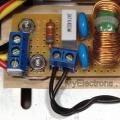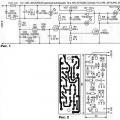Today, people are increasingly using energy-saving lamps in everyday life. The popularity of these lamps is primarily due to their economical energy consumption. After all, an energy-saving lamp saves money. Unlike an incandescent lamp, ESL gives a higher luminous flux with less power consumption.
The energy-saving lamp is installed in the same holder as a conventional incandescent lamp. The advantages of ESL are obvious, while there are practically no disadvantages. Therefore, it is not surprising that many people have long since switched to using so-called housekeepers instead of conventional incandescent bulbs.
The compact energy-saving lamp is a type of fluorescent lamp that has already become familiar to us. The ESL data is easily installed in the socket instead of the incandescent lamp. Lamps of this type have already firmly entered our life. And soon they will not be called "energy saving lamps", but simply "lamps".
Many people see in the operation of this lamp some kind of mystery, despite the simplicity of the device. Let's consider and try to understand the principle of its operation.
How an energy-saving lamp works
The device of almost all energy-saving lamps is the same. The lamp contains several parts. A gas discharge tube is the visible part of the lamp that emits light. The gas discharge tube is connected to the housing. The housing contains the inner part of the lamp, which is an electronic circuit for starting and supplying power. In another way, this circuit is called electronic ballast. The electronic circuit performs the task of igniting the lamp.
The base has contacts for powering the lamp and a thread for screwing into the socket. A conventional incandescent lamp has almost the same base as an ECL. The compact energy-saving lamp can be installed in small luminaires. There are several types of plinths that are common in Russia: G4, GU10, E40, E27, E14, G5.3.

Energy saving lamps with E40, E27 and E14 caps can be installed in sockets designed for a conventional incandescent lamp. E27 - a standard household cartridge, has a 27 mm thread, E14 - a reduced cartridge with a 14 mm thread, E40 - a cartridge with a 40 mm thread, refers to standard industrial cartridges.
A tube sealed on both sides is called an energy-saving lamp bulb. The electrodes are located at opposite ends of this bulb. The ES lamp has a curved bulb covered with phosphor layers. This flask contains an inert gas and a small amount of mercury vapor. Ionization of mercury vapor causes the light bulb to glow when the power is connected to it.
When voltage is applied to the electrodes, a heating current flows through them. It heats up the electrodes, which causes thermionic emission. When the electrodes reach a certain temperature, they emit a stream of electrons. Colliding with mercury atoms, electrons cause ultraviolet radiation, after which the ultraviolet radiation hits the phosphor, which converts this radiation into visible light. The color temperature of the lamp depends on the type of phosphor, it can be 2700-6500K.
Remember that mercury vapors are dangerous to the human body, so if the energy-saving lamp breaks, it is very important to properly dispose of the fragments and treat the place.
Have you ever wondered why the bulb in an energy-saving lamp has a bizarrely curved shape? Believe me, this was not done with ease. The curved shape of the bulb allows the entire lamp to be shortened. Due to the spiral winding, the length of the gas discharge tube itself can be increased, while the length of the lamp in this shape will be reduced. If this were not done, then not every such lamp was placed in an ordinary lamp or chandelier.
For the manufacture of the lamp housing, non-combustible plastic is used. The fluorescent lamp bulb is mounted at the top. The ballast, connecting wires and fuse are located in the housing. There is a marking on the surface of the lamp, it indicates the color temperature, power, supply voltage.
The internal structure of an energy-saving lamp
Inside the ESL case there is a round printed circuit board. A high-frequency converter is assembled on it. As a result of using a fairly high conversion frequency, there is no "blinking" that is characteristic of lamps with electromagnetic ballast (where a choke is used) operating at a frequency of 50 Hz. Modern lamps have a ballast equipped with an interference suppression filter. The filter protects against disturbances in the power supply network.
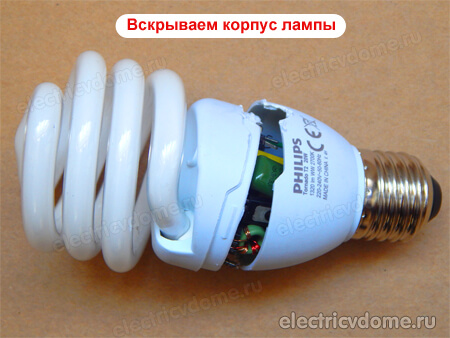
Getting to the electronic circuit is easy. Take a close look at the lamp, it is better to use a burned out one. It seems that the lamp body is impossible to disassemble. But this is a misconception. Closer to the bulb, there is a shallow groove at the top of the lamp. Take a small screwdriver or narrow blade and try to separate the case. After a little effort, you will have two parts in your hands. Difficulties may arise the first time, but then this operation will take a few seconds.
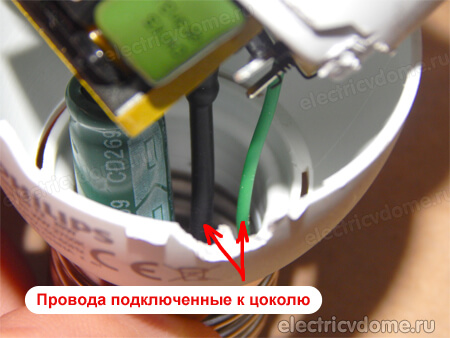
After separating the base from the bulb, these elements are interconnected by wires that must be carefully separated from the board. This can be done with a soldering iron, heating the soldering point, or simply by cutting the wires (but cut so that, then you can restore them).
In some types of lamps, the wires that go from the electronic board to the discharge tube are simply wound on special pins. After the wires are folded back, only then can you perform further inspection and diagnostics of the lamp. Next, disconnect the base from the electronic unit. For the convenience of extending the wires, they need to be cut in the middle.
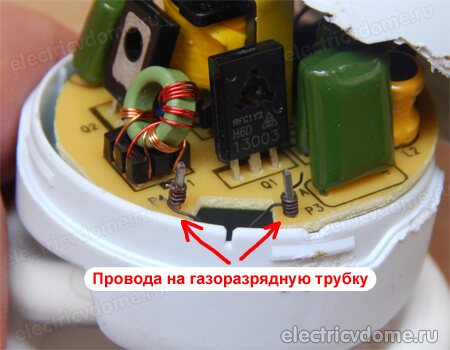
Inside you will see a circular board. This is the internal thanks to which it works. From overheating, the radio elements of the board, as a rule, are blackened (if you have a non-working lamp in your hands).
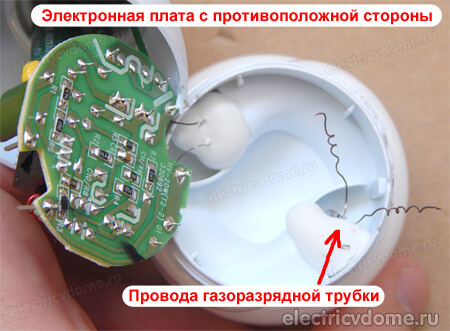
The wires from the bulb are tied to four square pins. They are located in pairs along the edges of the board. There is no soldering of wires, they are just tied, which is worth paying attention to.
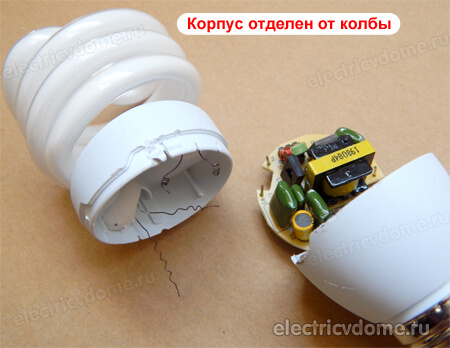
The fuse is the main element of the circuit. It protects all components of the electronic board from burnout. Sometimes an input limiting resistor is used instead of a fuse. When any malfunction occurs in the lamp, the current rises in the circuit, which leads to the combustion of the resistor, then the power circuit is broken.
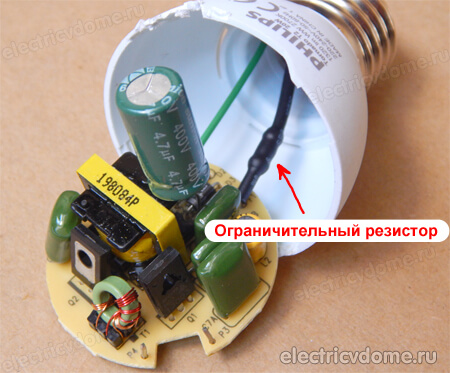
One terminal of the resistor is connected to the board, and the other is connected to the threaded contact of the base. Seated resistor in heat shrink tubing. The ripple of the rectified voltage is smoothed out by the capacitor. The choke or toroidal transformer has an annular magnetic circuit, usually 3 windings are located on it.
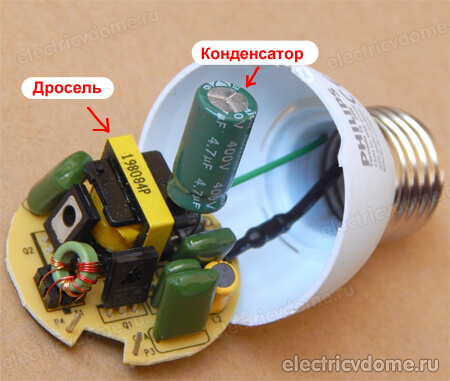
The flashing of the lamp at a mains frequency of 50 Hz occurs 100 times per second. Therefore, an energy-saving lamp can adversely affect the general physical condition of a person, his performance, especially if he is in such light conditions for a long time. All these harmful components have been eliminated in modern electronic ballasts. Therefore, there is no negative impact on the health of others.
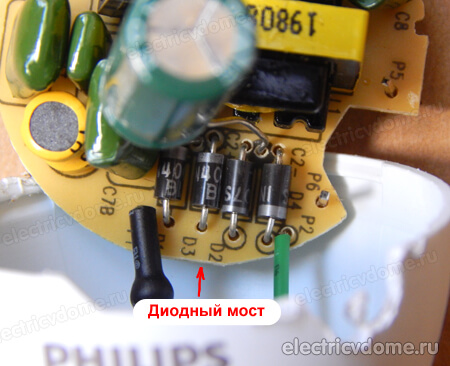
Modern electronic ballast is a small electronic circuit, it implements the functions of igniting the lamp without blinking, as well as smooth heating of the spirals of the lamp cathodes. In a modern energy-saving lamp, a gas glow with a frequency of 30-100 kHz. There is absolutely no noise during operation, and there is practically no electromagnetic field. At a high frequency (30-100 kHz), due to the close to unity coefficient of electricity consumption, an increased light output is formed.
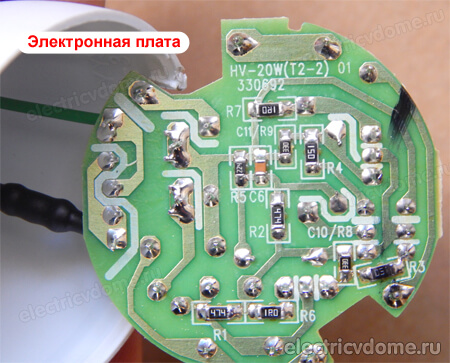
The lamp can ignite at full incandescence almost immediately, or the brightness can increase gradually. It depends on the ballast layout. In some lamps, the dimming process may take a couple of minutes. In this case, immediately after switching on, semi-darkness is observed. Unfortunately, the energy-saving lamp does not indicate which switching algorithm is used. You can understand the algorithm only after you have screwed the light bulb into the socket.
The principle of operation of an energy-saving lamp
With a question , we figured it out, now let's figure out in general terms how the lamp works.
On both sides inside the bulb there are two electrodes, anode and cathode, in the form of spirals. The discharge between the electrodes occurs after the power is applied. The current flows through a mixture of mercury vapor and inert gas. The lamp is lit when fast moving electrons collide with slow moving mercury atoms.
However, most of the light output (98%) produced by an energy saving lamp is ultraviolet. It is invisible to human sight. The light visible to a person, which comes from the lamp, arises thanks to the layers of the phosphor.
Under the influence of ultraviolet radiation, these layers glow. The color of the lighting produced by the fluorescent lamp depends on the chemical composition of the phosphor. The phosphor is applied to the inner surface of the glass bulb.



